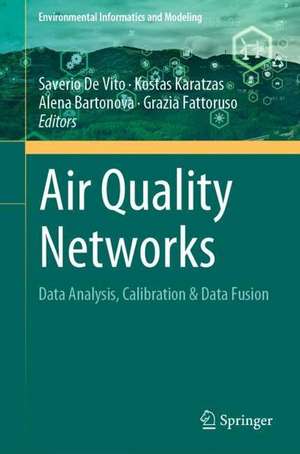Air Quality Networks: Data Analysis, Calibration & Data Fusion: Environmental Informatics and Modeling
Editat de Saverio De Vito, Kostas Karatzas, Alena Bartonova, Grazia Fattorusoen Limba Engleză Hardback – 2 ian 2023
| Toate formatele și edițiile | Preț | Express |
|---|---|---|
| Paperback (1) | 825.75 lei 38-44 zile | |
| Springer International Publishing – 3 ian 2024 | 825.75 lei 38-44 zile | |
| Hardback (1) | 786.73 lei 38-44 zile | |
| Springer International Publishing – 2 ian 2023 | 786.73 lei 38-44 zile |
Preț: 786.73 lei
Preț vechi: 1035.17 lei
-24% Nou
Puncte Express: 1180
Preț estimativ în valută:
150.56€ • 163.48$ • 126.47£
150.56€ • 163.48$ • 126.47£
Carte tipărită la comandă
Livrare economică 19-25 aprilie
Preluare comenzi: 021 569.72.76
Specificații
ISBN-13: 9783031084751
ISBN-10: 3031084756
Pagini: 178
Ilustrații: VII, 178 p. 86 illus., 73 illus. in color.
Dimensiuni: 155 x 235 mm
Greutate: 0.45 kg
Ediția:1st ed. 2023
Editura: Springer International Publishing
Colecția Springer
Seria Environmental Informatics and Modeling
Locul publicării:Cham, Switzerland
ISBN-10: 3031084756
Pagini: 178
Ilustrații: VII, 178 p. 86 illus., 73 illus. in color.
Dimensiuni: 155 x 235 mm
Greutate: 0.45 kg
Ediția:1st ed. 2023
Editura: Springer International Publishing
Colecția Springer
Seria Environmental Informatics and Modeling
Locul publicării:Cham, Switzerland
Cuprins
1. Future air quality networks.- 2. General data processing techniques.- 3. Fields deployments performances.- 4. Special applications.- 5. Cooperative and regulatory efforts.
Notă biografică
Saverio De Vito is a researcher at ENEA, Italian National Agency for New Technologies, Energy and Sustainable Economic Development. He holds a Ph.D. in Information Engineering. He was a SW architect specializing in TLC/EO satellite platforms and their applications. His research interests include artificial olfaction & vision, smart cyber physical systems, intelligent sensing, pattern recognition, and computer-aided diagnosis. During last decade He was involved in the reasearch efforts for the development of scalable, reliable, accurate low cost air quality monitoring networks, innovating the urban air quality monitoring in smart cities while supporting citizens awareness and involvement through citizens science and urban innovation projects. He has participated in several international research projects and has authored more than 70 contributions.
Grazia Fattoruso is a researcher at ENEA, Italian National Agency for New Technologies, Energy and Sustainable Economic Development. She is a geomatician with a PhD in Computer Science. Her research interests are in the fields of Geomatics, Spatial Statistics, Optimal sampling sensor placement, Numerical modeling, Spatially Distributed Sensors with several applications as Urban Air Quality management – site suitability map for networked sensors for urban AQ monitoring; urban air pollution mapping by opportunistic mobile monitoring. Photovoltaics - site suitability and solar potential (online) mapping for ground-mounted and integrated (buildings, agrivolatics) PV systems. Smart WAter Networks – patented innovative method and system for Cl and THMs concentrations monitoring in aqueducts. She has been involved in several EU and national research projects and She is (co)author of more than 70 scientific publications.
Textul de pe ultima copertă
This volume offers expert contributions proposing new and recently set scientific standards for smart air quality (AQ) networks data processing, along with results obtained during field deployments of pervasive and mobile systems. The book is divided into 5 main sections; 1) future air quality networks, 2) general data processing techniques, 3) field deployments performances, 4) special applications, and 5) cooperative and regulatory efforts. The authors offer different sources of data for the production of trustworthy insights, including spatio-temporal predictive AQ maps meant to boost citizen awareness, and informed participation in remediation and prevention policies. Readers will learn about the best and most up-to-date practices for measuring and assessing air quality, while also learning about current regulatory statuses regarding air quality technology design and implementation. The book will be of interest to air quality regulatory agencies, citizen science groups, city authorities, and researchers and students working with air quality sensors and geostatistics.
Caracteristici
Proposes new technical and scientific standards for smart air quality networks data processing Offers well-designed and engineered data processing pathways for the integration of different data sources Discusses high-resolution spatio-temporal predictive air quality maps
